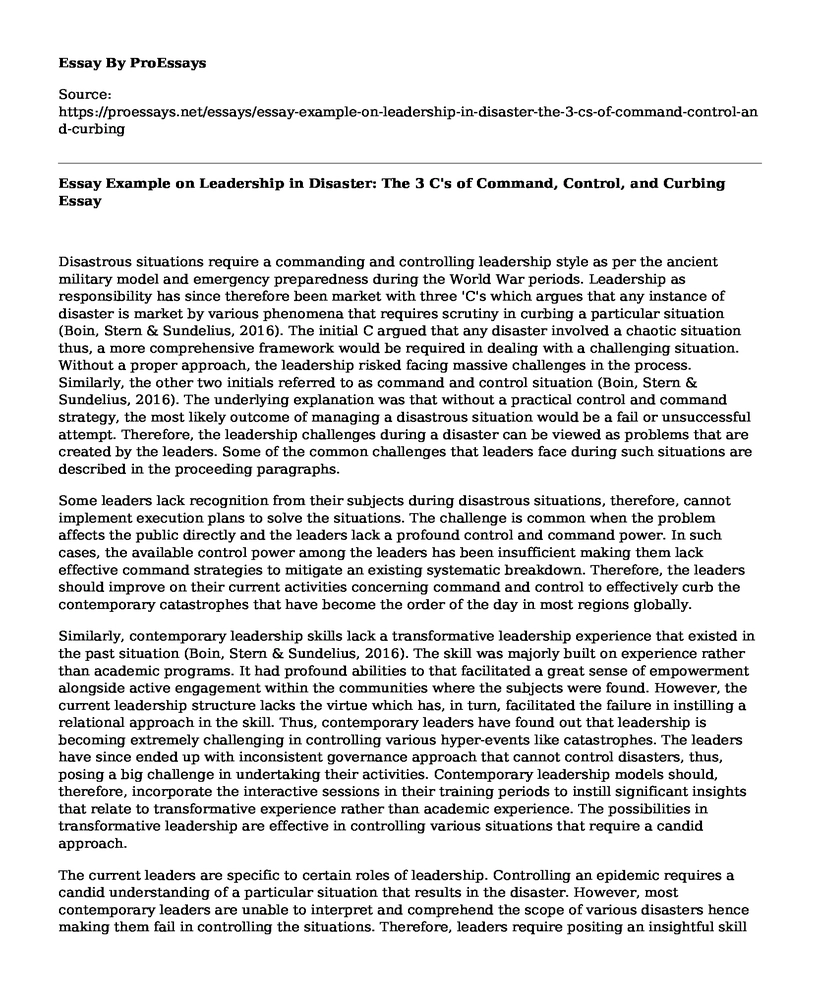Disastrous situations require a commanding and controlling leadership style as per the ancient military model and emergency preparedness during the World War periods. Leadership as responsibility has since therefore been market with three 'C's which argues that any instance of disaster is market by various phenomena that requires scrutiny in curbing a particular situation (Boin, Stern & Sundelius, 2016). The initial C argued that any disaster involved a chaotic situation thus, a more comprehensive framework would be required in dealing with a challenging situation. Without a proper approach, the leadership risked facing massive challenges in the process. Similarly, the other two initials referred to as command and control situation (Boin, Stern & Sundelius, 2016). The underlying explanation was that without a practical control and command strategy, the most likely outcome of managing a disastrous situation would be a fail or unsuccessful attempt. Therefore, the leadership challenges during a disaster can be viewed as problems that are created by the leaders. Some of the common challenges that leaders face during such situations are described in the proceeding paragraphs.
Some leaders lack recognition from their subjects during disastrous situations, therefore, cannot implement execution plans to solve the situations. The challenge is common when the problem affects the public directly and the leaders lack a profound control and command power. In such cases, the available control power among the leaders has been insufficient making them lack effective command strategies to mitigate an existing systematic breakdown. Therefore, the leaders should improve on their current activities concerning command and control to effectively curb the contemporary catastrophes that have become the order of the day in most regions globally.
Similarly, contemporary leadership skills lack a transformative leadership experience that existed in the past situation (Boin, Stern & Sundelius, 2016). The skill was majorly built on experience rather than academic programs. It had profound abilities to that facilitated a great sense of empowerment alongside active engagement within the communities where the subjects were found. However, the current leadership structure lacks the virtue which has, in turn, facilitated the failure in instilling a relational approach in the skill. Thus, contemporary leaders have found out that leadership is becoming extremely challenging in controlling various hyper-events like catastrophes. The leaders have since ended up with inconsistent governance approach that cannot control disasters, thus, posing a big challenge in undertaking their activities. Contemporary leadership models should, therefore, incorporate the interactive sessions in their training periods to instill significant insights that relate to transformative experience rather than academic experience. The possibilities in transformative leadership are effective in controlling various situations that require a candid approach.
The current leaders are specific to certain roles of leadership. Controlling an epidemic requires a candid understanding of a particular situation that results in the disaster. However, most contemporary leaders are unable to interpret and comprehend the scope of various disasters hence making them fail in controlling the situations. Therefore, leaders require positing an insightful skill that comprehends their understanding of a particular situation so that they can devise the best approaches to manage disasters. Besides, the skills will enable them to effectively respond to the outcoming results and manage them effectively.
On balance, contemporary leadership challenges are pure consequences of weak leadership skills that exist in the current society. The era of vibrant and able leaders who had a vast understanding of different situations is long gone. Therefore, the leaders should pose a responsible and insightful approach that creates a common understanding, inspiration, and hope for their subjects to become relevant to the public. With the considerations, they shall have devised practical approaches that would effectively manage disastrous situations.
Reference
Boin, A., Stern, E., & Sundelius, B. (2016). The politics of crisis management: Public leadership under pressure. Cambridge University Press.
Cite this page
Essay Example on Leadership in Disaster: The 3 C's of Command, Control, and Curbing. (2023, Apr 24). Retrieved from https://proessays.net/essays/essay-example-on-leadership-in-disaster-the-3-cs-of-command-control-and-curbing
If you are the original author of this essay and no longer wish to have it published on the ProEssays website, please click below to request its removal:
- Ethics in Organizational Decision-Making
- A Contemporary Nursing Leader: Dorothea Lynde Dix Paper Example
- Mosquito Mess in Ocean Side Community Paper Example
- Essay Example on Management Theory: A Guide to Achieving Business Goals
- Paper Example on Leadership in Multigenerational Workforces: Bridging the Gap
- Free Paper Example on Balanced Scorecard Strategies for Global Competitiveness
- Essay on Leadership and Responsibilities of Military Sergeants: Ensuring Operational Efficiency







